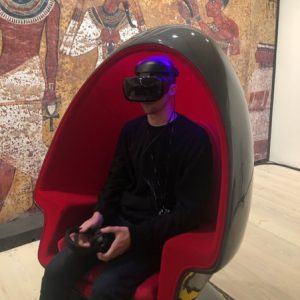As the coronavirus crisis wages on in the UK and around the world, museums, like many organisations, have found themselves forced to navigate this new reality. In particular, how to operate when physicality – interacting with original objects – remains at the heart of their endeavours. During the nationwide lockdown period especially, we witnessed how almost overnight, the material foundations of heritage were temporarily supplanted by online and virtual alternatives.
The changes in access brought on by the pandemic has only reignited tensions surrounding a shift away from objects within museums – a topic of current contention within heritage studies. Fears centre around the notion that museums are becoming more about the information they can provide, rather than their objects on display. With an increasing focus on digitisation, these anxieties have only inflated further – and to surprisingly existential proportions.
Indeed, current scholarship has perpetuated a narrative in which the “virtual” represents a threat to traditional heritage principles. In part fuelled by a desire to defend the object, detractorspropagate an almost dystopian-like future. A vision in which the digital “terrorist” will gradually and surreptitiously tear down the museum as a sanctuary for the authentic, the real and true. In this portrayal, virtual applications are reduced to nothing more than data-driven information dumps lacking the cultural essence of the objects they claim to emulate.
For my UG History Dissertation this research, this premise, elevated by the current climate, provided ample opportunity to explore this fractured relationship between the object and the virtual. The emergence of “virtual heritage” – a new field which emphasises the emotive, multi-sensory application of the digital, such as virtual reality –disrupts the leading narrative of hostility. Through this lens, the study set out to uncover a more comprehensive appraisal of the use of virtual heritage tools within museums.
Explorations of four virtual heritage experiences showed their potential to restore access to lost and inaccessible places. The wAVE Project’s plans to digitally restore an old harbour near St Agnes Museum, for example, holds purpose in injecting new life into what is “now no more than rubble on St Agnes beach.” The possibilities for immersion and interactivity within virtual spaces also offer unique opportunities to foster greater levels of engagement among visitors, not to mention affording them more agency and control as they participate more directly with these experiences.
Although, as a deeper dive into these experiences revealed, these prospects are not without their own caveats. The ambitions to extend cultural access can create more barriers to entry related to space; cost; malfunctions and technical proficiency. Meanwhile, the drive to promote visitor participation through the virtual realm also presents ethical considerations – such as whether it is appropriate to ask users to assume an active role in difficult histories – which has led to a reluctance to explore these interactive possibilities in practice.
Each of these factors, shadowed by underlying sacrifices, paint a complex picture for virtual heritage – certainly more so than its current portrayal as a threat. When the object is brought back into the conversation, this only provides further complications. Studies showing that digital engagement actually increases demand to access physical objects seem to dispel the myth of the virtual poised to usurp the real; clearly there is potential for both forms to unite in their shared endeavours.
Yet, among materialists, the continued demonisation of the digital dismisses any reasonable chances of this union at present. Some remain so caught up in guarding the object that they fail to see the double standards of their fears. For instance, many are quick to question the digital on grounds of authenticity but overlook how museum objects go through their own process of recontextualisation in their new role when placed on display.
Evidence of clouded judgments such as here suggests the more immediate implications of virtual heritage. It has further unearthed the deeply rooted materialist predilections present within museums. These principles remain embedded within the largely unproductive disputes over the status of the artefact and, alongside this, they can also contribute to an exclusionary culture of practice.
As a consequence, new or unconventional modes of visitor engagement, such as virtual heritage, seem to be roped into these debates when really, in a more practical view, their proponents would prefer to focus their energies elsewhere. Namely on establishing their field and honing their attempts to enrich museum activities. Indulging in such arguments ultimately detracts from finding out what virtual heritage can offer in its own right. In this new age, during a period of new mindsets and approaches in all walks of life, perhaps now the digital will get its chance.
By Matt Solomons
This post was adapted from Matt’s recently submitted undergraduate dissertation entitled “Do museums still need objects in the age of virtual heritage?”. Access to the full text is available here.

A virtual reality “pod” as part of a Tutankhamun exhibition last year. Could this image soon become the norm?
